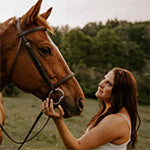Spring's arrival brings lush, green grass to once-dormant horse pastures.
While horse owners and horses alike are excited to enjoy these fresh spring pastures, a well-timed and gradual transition is necessary to prevent potential health issues—especially for horses with certain risk factors.
This comprehensive guide delves into the changes in spring pastures, the associated risks of grazing fresh spring grass, and strategies to safely transition horses to spring pasture grass.
Understanding Spring Pasture Growth
During winter, most grasses and forage plants go dormant waiting for the warmer, longer days of spring to start growing again.
As soil temperatures rise, particularly above 41°F (5°C), cool-season grasses like Kentucky bluegrass, perennial ryegrass, orchard grass, timothy, bromegrass and others begin growing, with optimal growth happening around 68°F (20°C). These plants use sunlight to produce sugars and starches, known as non-structural carbohydrates (NSCs), which help them grow quickly.
It's important to understand that NSC levels in plants change throughout the day. These levels are at their highest in the late afternoon, after a full day of photosynthesis, and the NSC levels naturally decrease overnight as the plant uses them for growth.
However, if the temperature drops below 41°F at night, plant growth stops, causing NSC levels to stay high even in the morning. This makes it essential to be cautious when letting horses graze during these times.
Why Caution Is Necessary When Introducing Horses to Spring Pasture
Fresh spring grass is highly palatable and nutrient-rich for horses. However, it also contains high levels of NSCs due to the way it grows as mentioned above.
Horses with underlying metabolic conditions respond poorly to the rapid influx of NSC in the diet.
Horses at higher risk when being introduced to spring pasture grass include those with:
-
Equine Metabolic Syndrome
-
Polysaccharide Storage Myopathy (PSSM)
-
Developmental Orthopedic Disorders
-
A history of colic or laminitis
-
Hyperactivity
-
Digestive sensitivities
Even healthy horses can experience digestive upset if their systems are not properly acclimated to a change in diet—including fresh spring grass. A slow transition is essential to prevent these health complications. Horses who are not acclimated to fresh forage risk significant disturbances to the microbial balance of the hindgut. This can cause various health issues, with the risk level dependent on the individual horse.
Health Risks of Spring Pasture Grazing
Introducing horses to lush spring pastures without a gradual transition can lead to several serious health complications:
-
Colic: Rapid fermentation of highly digestible fiber in the hindgut can cause gas buildup, leading to discomfort and potential colic episodes due to microbial imbalance or gas colic.
-
Laminitis: High NSC intake can trigger inflammation of the laminae in the hooves, causing pain and potential lameness.
-
Equine Metabolic Syndrome (EMS): Horses predisposed to metabolic disorders may experience exacerbated symptoms when exposed to high-NSC diets.
Strategies for a Safe Transition to Spring Pastures
To mitigate these risks, a gradual introduction to spring grazing is vital.
Assess Pasture Readiness:
Ensure the pasture grass has reached a minimum height of 6 inches (15 cm) before letting horses graze on it. This practice also helps promote pasture longevity by preventing pastures from becoming quickly overgrazed.
Implement a Controlled Grazing Schedule:
Begin with short grazing periods and incrementally increase exposure:
-
Days 1-3: Allow 15 minutes of grazing daily
-
Subsequent Days: Increase grazing time by 15 minutes each day
-
By Day 16: Horses can graze for approximately 3.5 hours
-
After Day 16: If no adverse reactions are observed, consider unrestricted pasture access

This approach allows the equine digestive system and its gut microbial to adapt to the new forage, reducing the likelihood of digestive upset.
To further ensure a smooth and safe transition to spring pasture grass:
Monitor Environmental Conditions:
Be attentive to temperature fluctuations, especially in early spring. During cold spells, especially nights where temperatures fall below 41°F, consider reducing grazing times, as NSC levels in plants remain elevated under these conditions.
Utilize Grazing Muzzles:
For horses prone to overconsumption or those with metabolic concerns, grazing muzzles can effectively limit forage intake, reducing the risk of NSC overload. However, be mindful that horses might find a way to get these off, so be sure to check on them in the pasture periodically.
Maintain Supplemental Forage:
Continue providing hay during the pasture grass transition period to ensure consistent forage intake and to support digestive health.
Special Considerations During Spring Pasture Grass: Transitioning At-Risk Horses
Horses that have had laminitis, EMS, or other metabolic issues need additional monitoring and care during this spring pasture grass transition:
-
Consultation: Talk to your veterinarian to develop a specific grazing plan that aligns with the horse's health condition.
-
Restricted Grazing: Limit access to lush pastures, especially during peak NSC periods, to prevent exacerbation of underlying conditions.
-
Alternative Forage: Provide low-NSC hay or utilize dry lots to manage forage intake without compromising nutritional needs.
Spring Pasture Management Practices
Effective pasture management not only benefits equine health but also ensures spring pastures thrive.
-
Rotational Grazing: Implement rotational grazing of different pastures whenever possible to allow forage recovery and reduce overgrazing.
-
Weed Control: Manage weed populations to ensure high-quality pasture forage and prevent the spread of undesirable weed plant species during the spring.
-
Parasite Control: Spring also brings an increase in intestinal parasites. Consult with your veterinarian to do routine Fecal Egg Count (FEC) tests and establish a deworming protocol suited to your horse’s individual needs. Additionally, pasture grazing rotations not only help prevent overgrazing, but they can also reduce parasite loads, as horses are not continuously exposed to concentrated areas of parasite eggs in the same pasture.
Key Takeaways
Transitioning horses to spring pastures is a process that demands careful planning and execution.
By understanding the physiological changes in spring grass, recognizing potential health risks, and implementing gradual grazing strategies, horse owners can ensure their horses enjoy the benefits of fresh pasture while minimizing adverse health conditions.
Continuing to monitor horses and using best pasture management practices are essential to maintain both equine well-being and pasture vitality.


